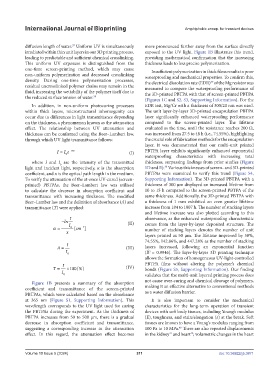Page 319 - IJB-10-5
P. 319
International Journal of Bioprinting Amphiphobic encap. for transient devices
diffusion length of water. Uniform UV is simultaneously more pronounced further away from the surface directly
37
irradiated within thin unit layers in our 3D printing process, exposed to the UV light. Figure 1B illustrates this trend,
leading to predictable and sufficient chemical crosslinking. providing mathematical confirmation that the increasing
This uniform UV exposure is distinguished from the thickness leads to less precise polymerization.
one-time screen-printing method, which may cause Insufficient polymerization in thick films results in poor
non-uniform polymerization and decreased crosslinking waterproofing and mechanical properties. To confirm this,
density. During one-time polymerization processes, the electrical dissolution rate (EDR) of the Mg resistor was
39
residual uncrosslinked polymer chains may remain in the measured to compare the waterproofing performance of
fluid, increasing the wettability of the polymer itself due to the 3D-printed PBTPA with that of screen-printed PBTPA
the reduced surface tension of water. 38 (Figures 1C and S2, S3, Supporting Information). For the
In addition, in non-uniform photocuring processes EDR test, Mg/Cr with a thickness of 300/20 nm was used.
within thick layers, microstructural inhomogenity can The unit layer-by-layer 3D-printed encapsulation PBTPA
occur due to differences in light transmittance depending layer significantly enhanced waterproofing performance
on the thickness, a phenomenon known as the attenuation compared to the screen-printed layer. The lifetime
effect. The relationship between UV attenuation and evaluated as the time, until the resistance reaches 200 Ω,
thickness can be confirmed using the Beer–Lambert law, was increased from 27.5 to 48 h (i.e., 74.55%), highlighting
through which UV light transmittance follows: the crucial role of fabrication methods for the encapsulation
layer. It was demonstrated that our multi-unit printed
I = I e −α x (I) PBTPA layer exhibits significantly enhanced exponential
0 waterproofing characteristics with increasing total
where I and I are the intensity of the transmitted thickness, surpassing findings from prior studies (Figure
0
30
light and incident light, respectively, α is the absorption 1D and E). Various thicknesses of screen- and 3D-printed
coefficient, and x is the optical path length in the medium. PBTPAs were examined to verify this trend (Figure S4,
To verify the attenuation of the at-once UV-cured (screen- Supporting Information). The 3D-printed PBTPA with a
printed) PBTPAs, the Beer–Lambert law was utilized thickness of 300 μm displayed an increased lifetime from
to calculate the decrease in absorption coefficient and 10 to 15 h compared to the screen-printed PBTPA of the
transmittance with increasing thickness. The modified same thickness. Additionally, the 3D-printed PBTPA with
Beer–Lamber law and the definition of absorbance (A) and a thickness of 1 mm exhibited an even greater lifetime
transmittance (T) were applied: increase from 184 to 1007 h. The number of stacking layers
and lifetime increase was also plotted according to this
I observance, as the enhanced waterproofing characteristic
−ln (II)
α = I 0 [ cm ] comes from the layer-by-layer deposited structure. The
−1
x number of stacking layers denotes the number of unit
layers printed as 50 μm. The lifetime improved by 50%,
74.55%, 142.86%, and 447.28% as the number of stacking
I
A ≡ (III) layers increased, following an exponential function
I 0 (R = 0.9946). The layer-by-layer 3D printing technique
2
allows the formation of homogeneous UV-light-controlled
I PBTPA films without altering the polymer’s chemical
T ≡ ×100[%] (IV) bonds (Figure S5, Supporting Information). Our finding
I 0 validates that the multi-unit layered printing process does
Figure 1B presents a summary of the absorption not cause over-curing and chemical cleavage of polymers,
coefficient and transmittance of the screen-printed making it an effective alternative to conventional methods
PBTPAs, which were calculated based on the absorbance as a water diffusion barrier.
at 365 nm (Figure S1, Supporting Information). This It is also important to consider the mechanical
wavelength corresponds to the UV light used for curing characteristics for the long-term operation of transient
the PBTPAs during the experiment. As the thickness of devices with soft body tissues, including Young’s modulus
PBTPA increases from 50 to 500 μm, there is a gradual (E), toughness, and stain/elongation (ε) at the break. Soft
decrease in absorption coefficient and transmittance, tissues are known to have a Young’s modulus ranging from
suggesting a corresponding increase in the attenuation 100 Pa to 10 MPa. There are also repeated displacements
40
42
effect. In this regard, the attenuation effect becomes in the kidney and heart ; volumetric changes in the heart
41
Volume 10 Issue 5 (2024) 311 doi: 10.36922/ijb.3871

